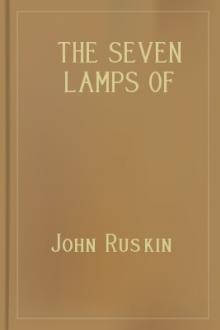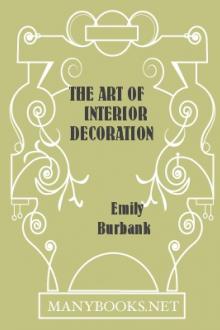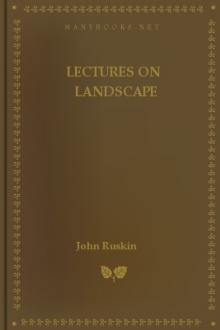The Seven Lamps of Architecture by John Ruskin (books like harry potter TXT) 📕

- Author: John Ruskin
- Performer: -
Book online «The Seven Lamps of Architecture by John Ruskin (books like harry potter TXT) 📕». Author John Ruskin
IV. This is no slight, no consequenceless evil: it is ominous, infectious, and fecund of other fault and misfortune. When men do not love their hearths, nor reverence their thresholds, it is a sign that they have dishonored both, and that they have never acknowledged the true universality of that Christian worship which was indeed to supersede the idolatry, but not the piety, of the pagan. Our God is a household God, as well as a heavenly one; He has an altar in every man's dwelling; let men look to it when they rend it lightly and pour out its ashes. It is not a question of mere ocular delight, it is no question of intellectual pride, or of cultivated and critical fancy, how, and with what aspect of durability and of completeness, the domestic buildings of a nation shall be raised. It is one of those moral duties, not with more impunity to be neglected because the perception of them depends on a finely toned and balanced conscientiousness, to build our dwellings with care, and patience, and fondness, and diligent completion, and with a view to their duration at least for such a period as, in the ordinary course of national revolutions, might be supposed likely to extend to the entire alteration of the direction of local interests. This at the least; but it would be better if, in every possible instance, men built their own houses on a scale commensurate rather with their condition at the commencement, than their attainments at the termination, of their worldly career; and built them to stand as long as human work at its strongest can be hoped to stand; recording to their children what they have been, and from what, if so it had been permitted them, they had risen. And when houses are thus built, we may have that true domestic architecture, the beginning of all other, which does not disdain to treat with respect and thoughtfulness the small habitation as well as the large, and which invests with the dignity of contented manhood the narrowness of worldly circumstance.
V. I look to this spirit of honorable, proud, peaceful self-possession, this abiding wisdom of contented life, as probably one of the chief sources of great intellectual power in all ages, and beyond dispute as the very primal source of the great architecture of old Italy and France. To this day, the interest of their fairest cities depends, not on the isolated richness of palaces, but on the cherished and exquisite decoration of even the smallest tenements of their proud periods. The most elaborate piece of architecture in Venice is a small house at the head of the Grand Canal, consisting of a ground floor with two stories above, three windows in the first, and two in the second. Many of the most exquisite buildings are on the narrower canals, and of no larger dimensions. One of the most interesting pieces of fifteenth century architecture in North Italy, is a small house in a back street, behind the market-place of Vicenza; it bears date 1481, and the motto, Il. n'est. rose. sans. épine; it has also only a ground floor and two stories, with three windows in each, separated by rich flower-work, and with balconies, supported, the central one by an eagle with open wings, the lateral ones by winged griffins standing on cornucopiæ. The idea that a house must be large in order to be well built, is altogether of modern growth, and is parallel with the idea, that no picture can be historical, except of a size admitting figures larger than life.
VI. I would have, then, our ordinary dwelling-houses built to last, and built to be lovely; as rich and full of pleasantness as may be, within and without; with what degree of likeness to each other in style and manner, I will say presently, under another head; but, at all events, with such differences as might suit and express each man's character and occupation, and partly his history. This right over the house, I conceive, belongs to its first builder, and is to be respected by his children; and it would be well that blank stones should be left in places, to be inscribed with a summary of his life and of its experience, raising thus the habitation into a kind of monument, and developing, into more systematic instructiveness, that good custom which was of old universal, and which still remains among some of the Swiss and Germans, of acknowledging the grace of God's permission to build and possess a quiet resting-place, in such sweet words as may well close our speaking of these things. I have taken them from the front of a cottage lately built among the green pastures which descend from the village of Grindelwald to the lower glacier:—
"Mit herzlichem Vertrauen
Hat Johannes Mooter und Maria Rubi
Dieses Haus bauen lassen.
Der liebe Gott woll uns bewahren
Vor allem Unglück und Gefahren,
Und es in Segen lassen stehn
Auf der Reise durch diese Jammerzeit
Nach dem himmlischen Paradiese,
Wo alle Frommen wohnen,
Da wird Gott sie belohnen
Mit der Friedenskrone
Zu alle Ewigkeit."
VII. In public buildings the historical purpose should be still more definite. It is one of the advantages of Gothic architecture,—I use the word Gothic in the most extended sense as broadly opposed to classical,—that it admits of a richness of record altogether unlimited. Its minute and multitudinous sculptural decorations afford means of expressing, either symbolically or literally, all that need be known of national feeling or achievement. More decoration will, indeed, be usually required than can take so elevated a character; and much, even in the most thoughtful periods, has been left to the freedom of fancy, or suffered to consist of mere repetitions of some national bearing or symbol. It is, however, generally unwise, even in mere surface ornament, to surrender the power and privilege of variety which the spirit of Gothic architecture admits; much more in important features—capitals of columns or bosses, and string-courses, as of course in all confessed bas-reliefs. Better the rudest work that tells a story or records a fact, than the richest without meaning. There should not be a single ornament put upon great civic buildings, without some intellectual intention. Actual representation of history has in modern times been checked by a difficulty, mean indeed, but steadfast: that of unmanageable costume; nevertheless, by a sufficiently bold imaginative treatment, and frank use of symbols, all such obstacles may be vanquished; not perhaps in the degree necessary to produce sculpture in itself satisfactory, but at all events so as to enable it to become a grand and expressive element of architectural composition. Take, for example, the management of the capitals of the ducal palace at Venice. History, as such, was indeed entrusted to the painters of its interior, but every capital of its arcades was filled with meaning. The large one, the corner stone of the whole, next the entrance, was devoted to the symbolisation of Abstract Justice; above it is a sculpture of the Judgment of Solomon, remarkable for a beautiful subjection in its treatment to its decorative purpose. The figures, if the subject had been entirely composed of them, would have awkwardly interrupted the line of the angle, and diminished its apparent strength; and therefore in the midst of them, entirely without relation to them, and indeed actually between the executioner and interceding mother, there rises the ribbed trunk of a massy tree, which supports and continues the shaft of the angle, and whose leaves above overshadow and enrich the whole. The capital below bears among its leafage a throned figure of Justice, Trajan doing justice to the widow, Aristotle "che die legge," and one or two other subjects now unintelligible from decay. The capitals next in order represent the virtues and vices in succession, as preservative or destructive of national peace and power, concluding with Faith, with the inscription "Fides optima in Deo est." A figure is seen on the opposite side of the capital, worshipping the sun. After these, one or two capitals are fancifully decorated with birds (Plate V.), and then come a series representing, first the various fruits, then the national costumes, and then the animals of the various countries subject to Venetian rule.
VIII. Now, not to speak of any more important public building, let us imagine our own India House adorned in this way, by historical or symbolical sculpture: massively built in the first place; then chased with bas-reliefs of our Indian battles, and fretted with carvings of Oriental foliage, or inlaid with Oriental stones; and the more important members of its decoration composed of groups of Indian life and landscape, and prominently expressing the phantasms of Hindoo worship in their subjection to the Cross. Would not one such work be better than a thousand histories? If, however, we have not the invention necessary for such efforts, or if, which is probably one of the most noble excuses we can offer for our deficiency in such matters, we have less pleasure in talking about ourselves, even in marble, than the Continental nations, at least we have no excuse for any want of care in the points which insure the building's endurance. And as this question is one of great interest in its relations to the choice of various modes of decoration, it will be necessary to enter into it at some length.
IX. The benevolent regards and purposes of men in masses seldom can be supposed to extend beyond their own generation. They may look





Comments (0)